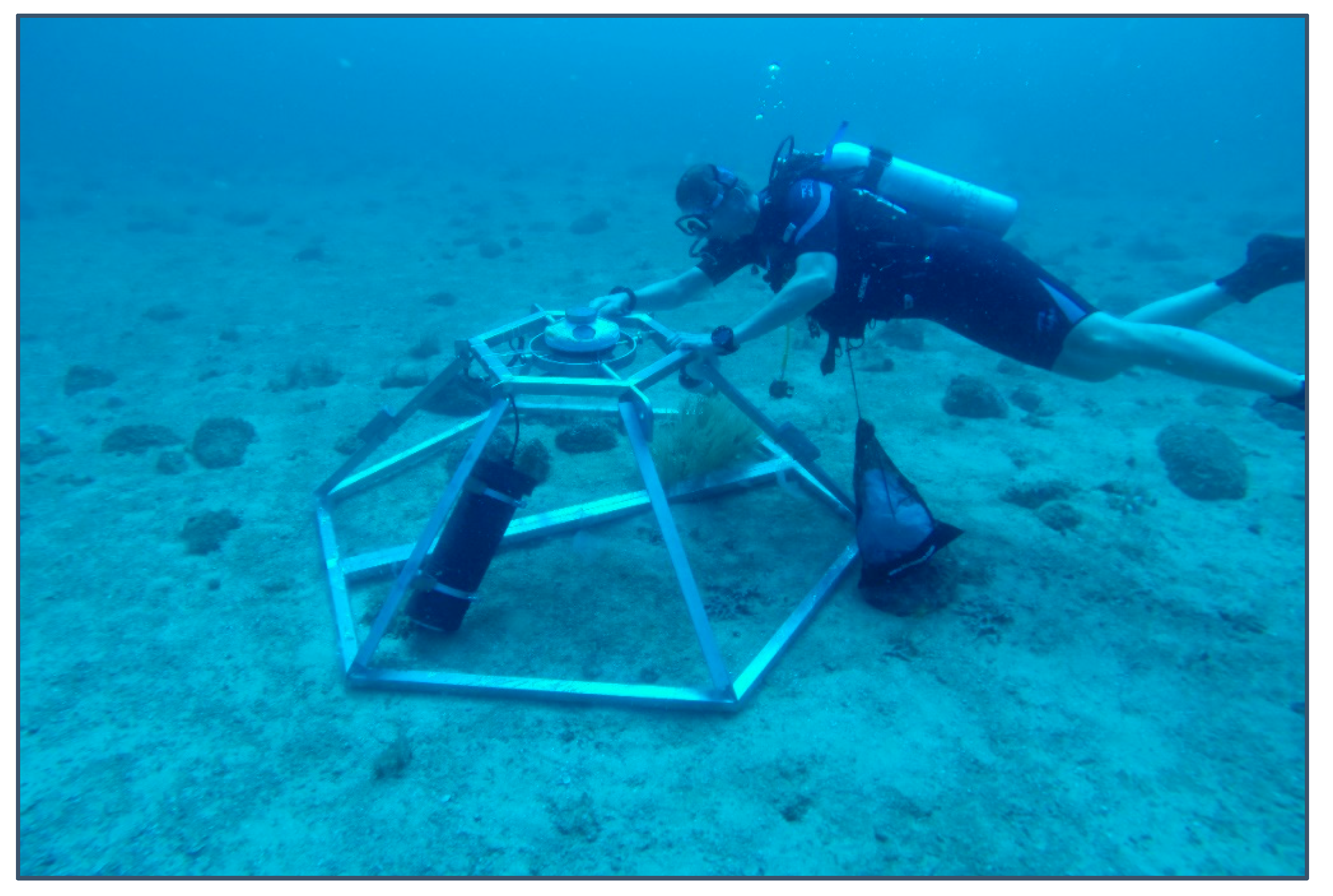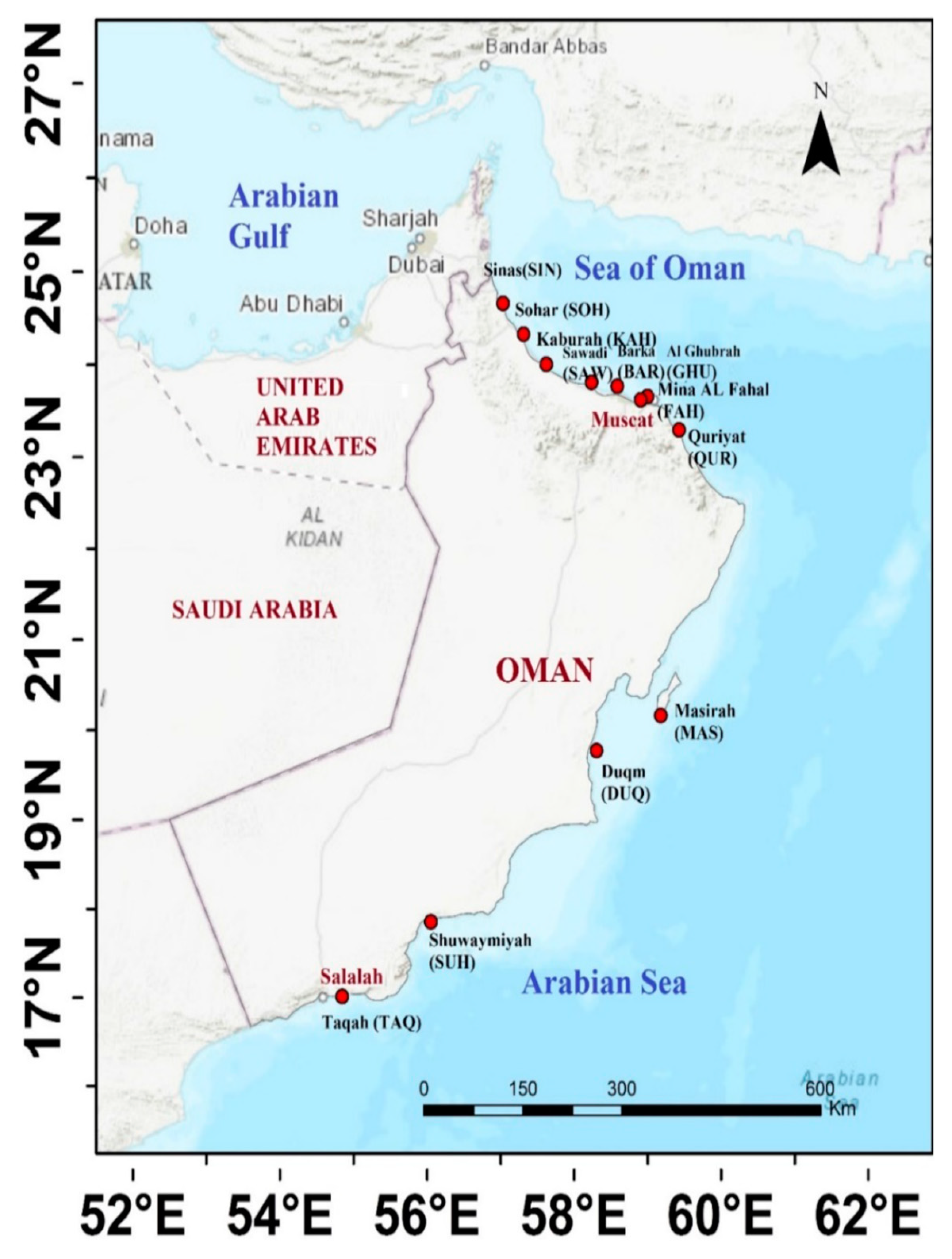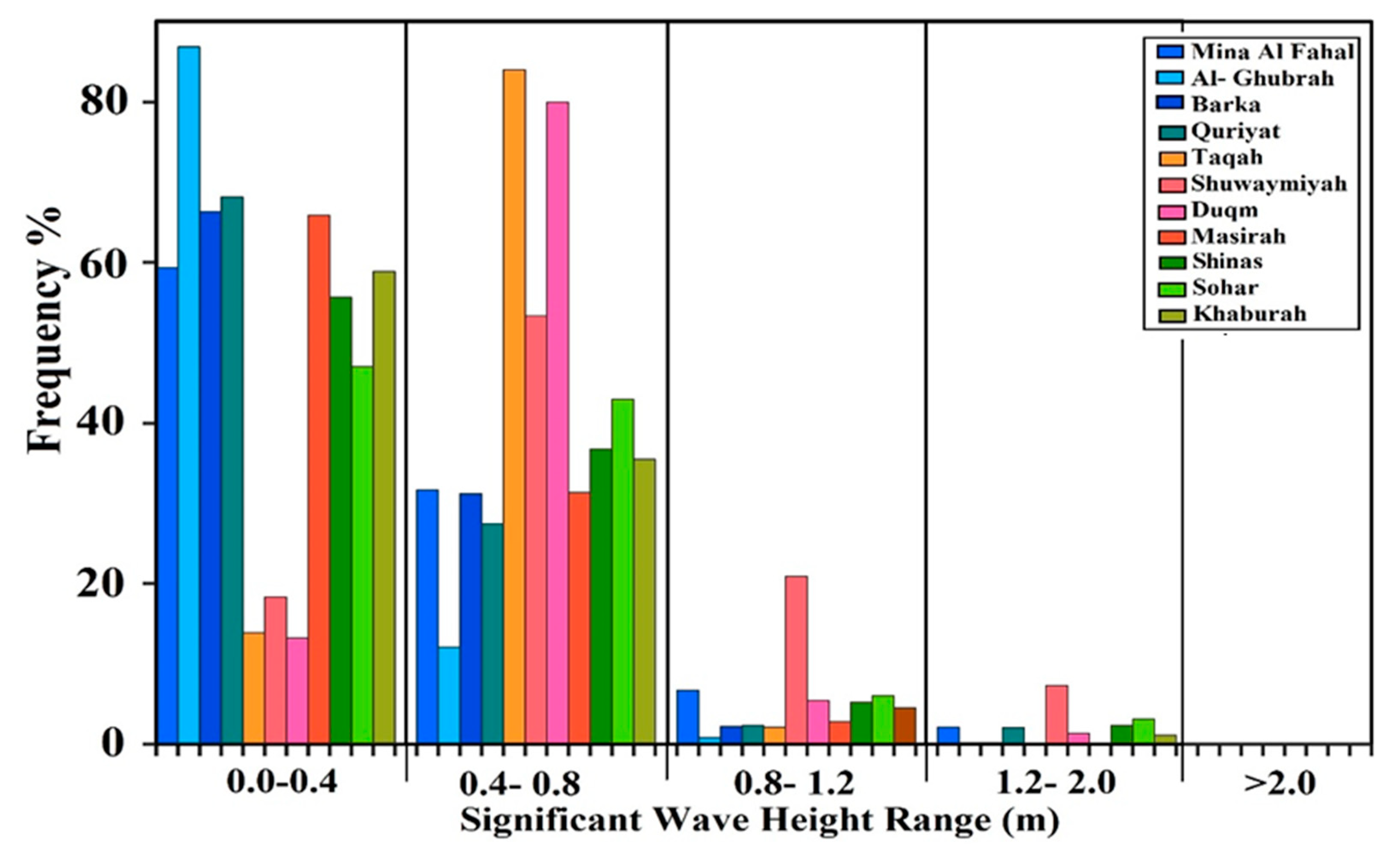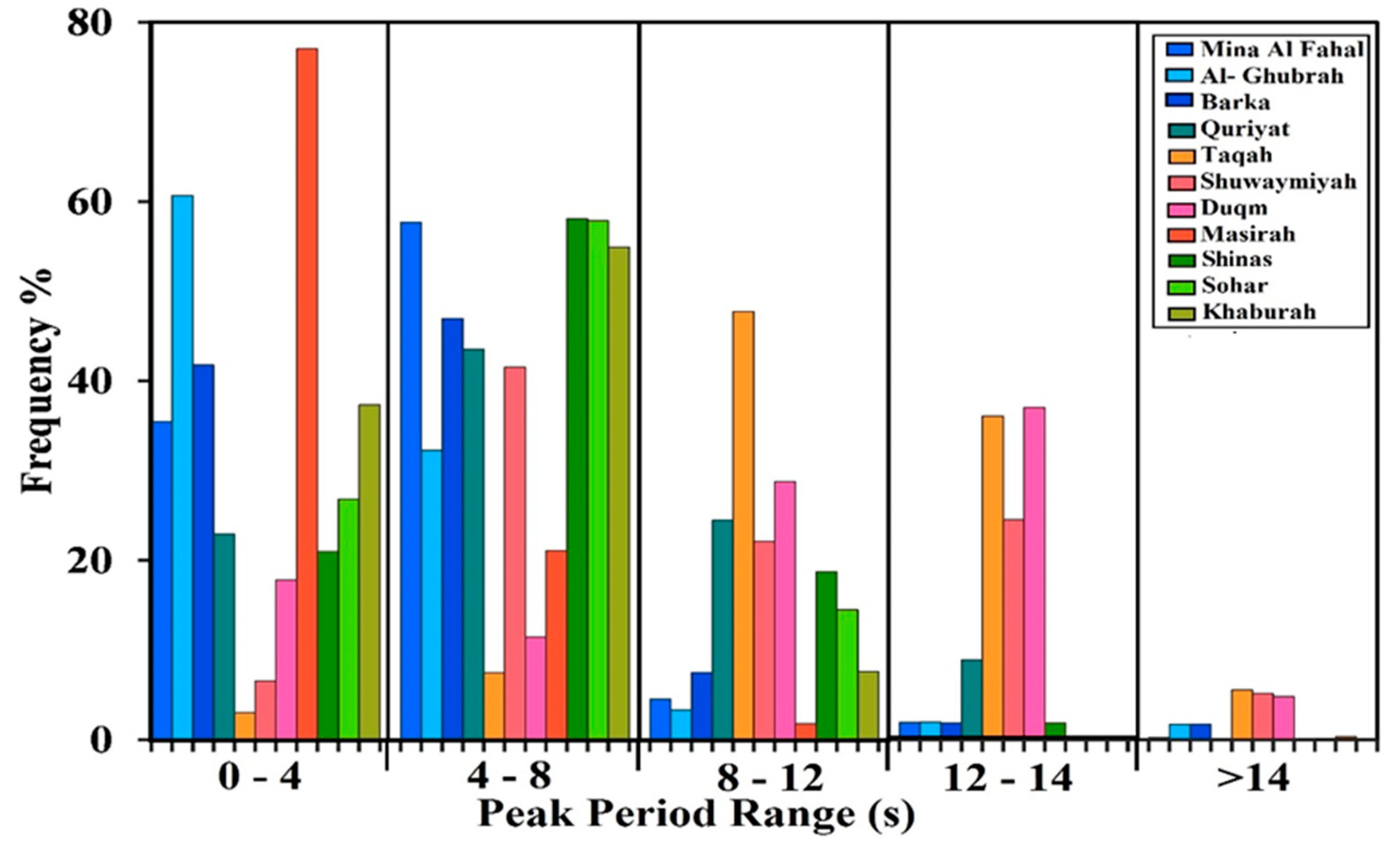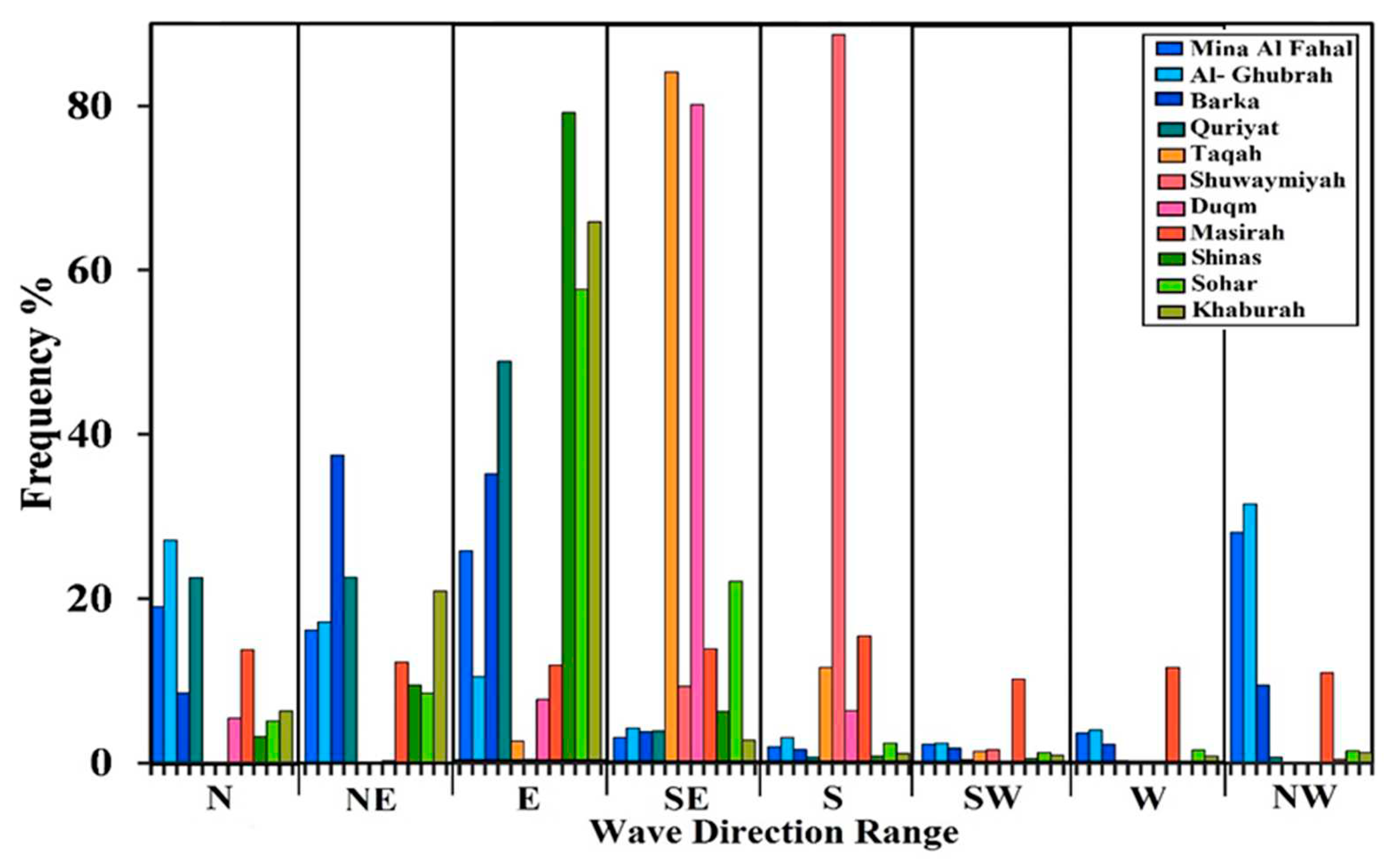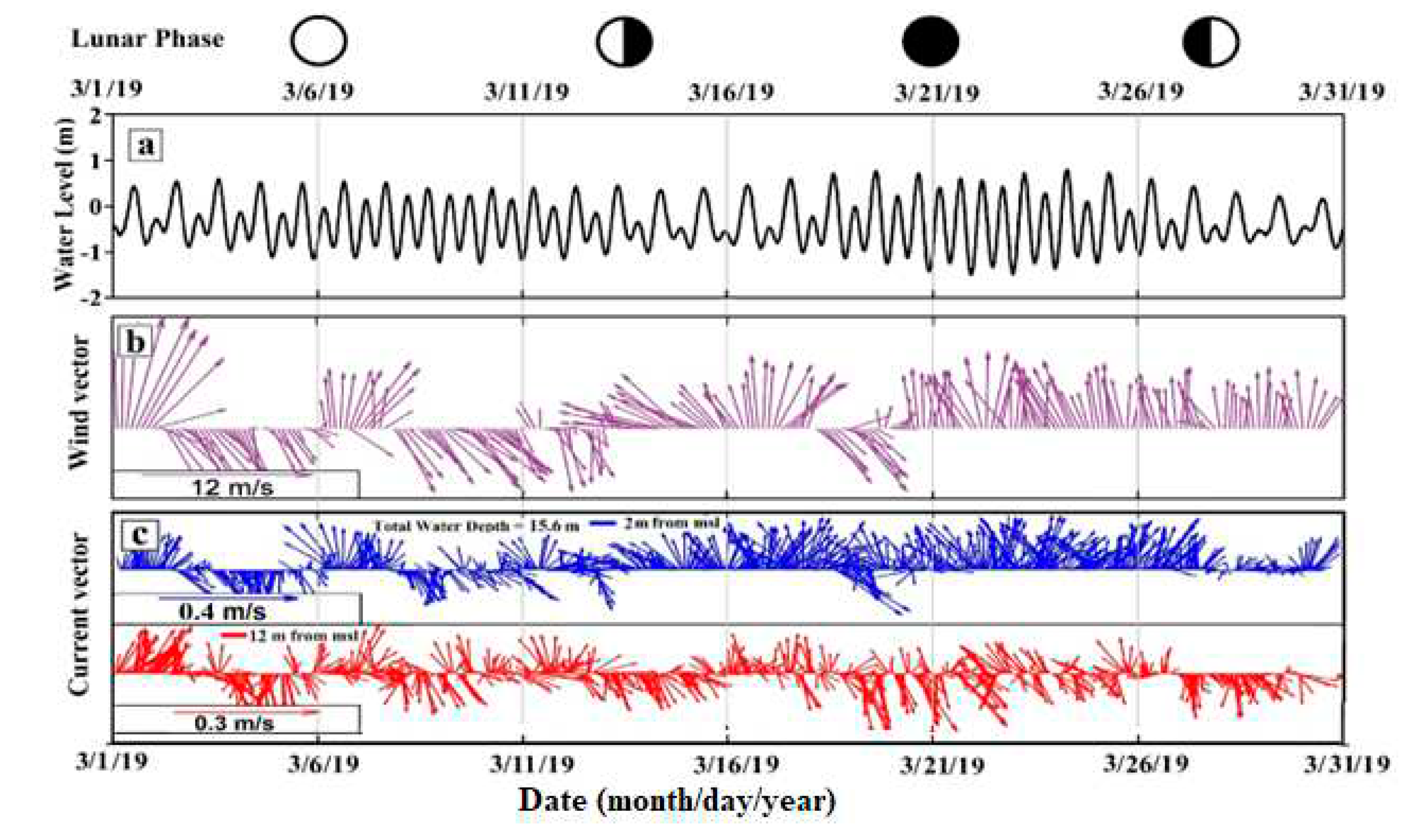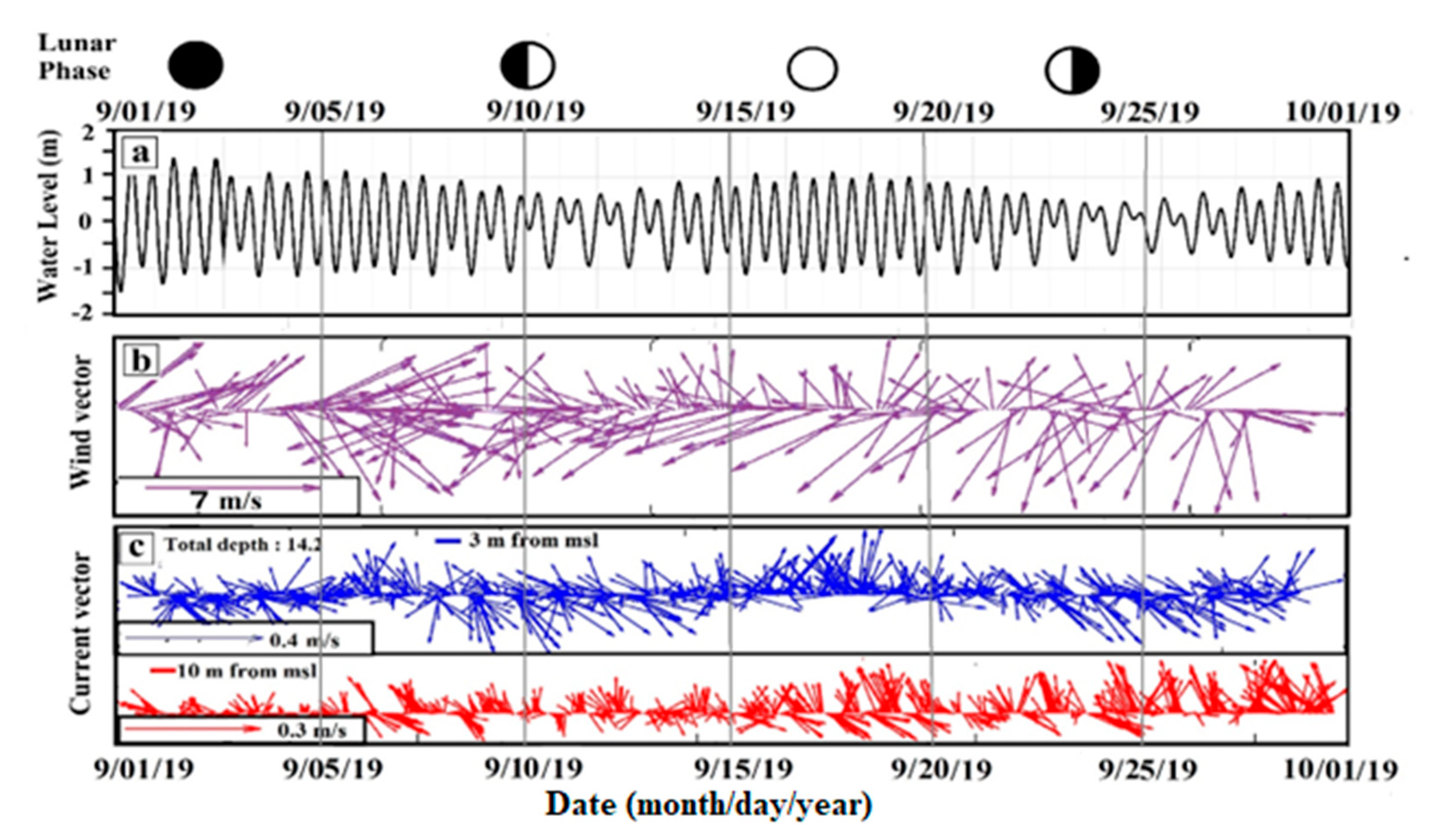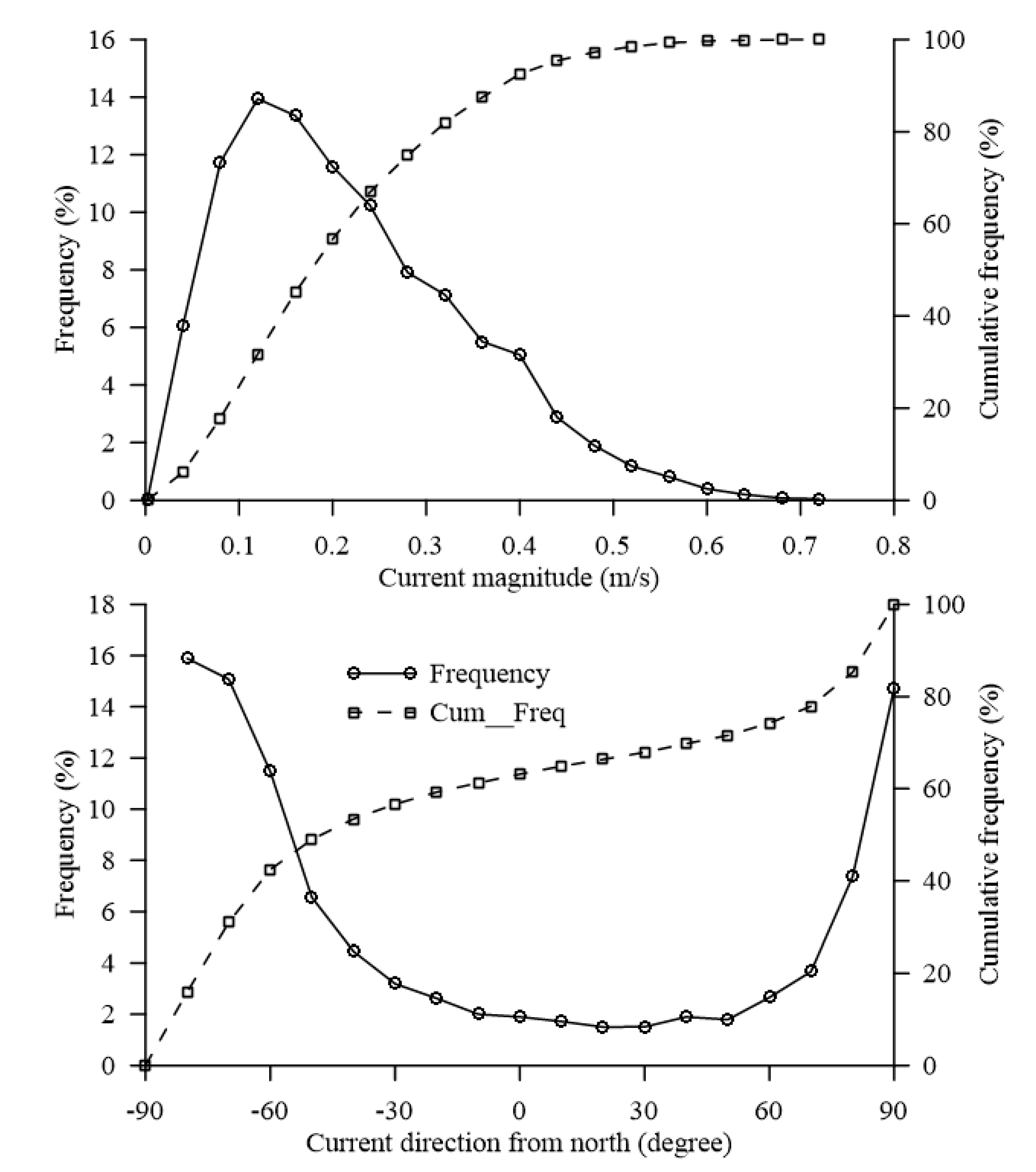1. Introduction
Coastal currents play an important role in the hydrodynamic transport processes near the coastlines. Since early seventies the increase in oil and gas production, operational vessel activities, coastal and industrial development, desalination, and wastewater treatment are the main sources of damage to the marine environment in the Sea of Oman [
1]. The pollution caused by accidental and intentional spills, ballast water discharge, brine disposal, toxic waste discharge, dredging, and land reclamations has led to severe ecological damage to the coastal environment and the marine ecosystem. Preventive and control strategies are put in place to fight both land and sea-based pollution and thus to safeguard the marine ecology of the region. Therefore, continuous monitoring of hydrodynamic and seawater quality parameters along the Omani coast is imperative to improve the understanding of sediment transport, erosion, and deposition mechanisms in this region [
2].
The Sea of Oman (previously known as Gulf of Oman) is situated in subtropical zone with depth varying from 3,000 m in oceanic part and gets shallower towards the Strait of Hormuz with the varying depth of 70-110 m separating it from the Persian Gulf and has, a total area of 94,000 km2. The Strait of Hormuz is 56 km wide and roughly 90 m deep but for a trough near and around the Musandam Peninsula. While the Arabian Sea stretches 1200 km along the Omani coast from Ras Al-Hadd in the north to the Oman-Yemen border in the south. The open Arabian Sea has a total area of 3,862,000 km2, with a depth up to 4652 m.
Atmospheric conditions over Persian Gulf and Sea of Oman are north-westerly winds, with seasonal variations over the Sea of Oman, high pressures in winter (1015 hPa) with relatively low in summer (995 hPa) and air temperatures varying between 32–34 oC in summer and 18
oC–20
oC in winter. Hydrologically, Sea of Oman during summer experiences the Southwest Monsoon (SWM) oscillated from the Persian Gulf transmitting toward the Arabian Sea through it. In winter, Northwest Monsoon (NWM) from the oceanic regions of the Arabian Sea moves toward the Gulf passing through Sea of Oman along the Iranian coast in the North. Circulation in Sea of Oman is dominated by a clockwise gyre in the west and counterclockwise gyre in the east, creating upwelling circulation in both summer and winter, whose strength depends on prevailing winds [
3].
The tide from the Persian Gulf oscillates to the Sea of Oman through narrow Strait of Hormuz which further co-oscillates towards the Arabian Sea. Those tides are complex standing waves and vary from primarily semi-diurnal to diurnal pattern [
3]. Akbari et al. [
4] observed the tides in the Persian Gulf which is standing wave, and progressive waves passing by the sea surface in the Sea of Oman and the Arabian Sea. Wind and tides predominantly result in high water level fluctuation in the Sea of Oman and the Persian Gulf with tide height varying from 1.5m to 4.5m [
5]. Although the coast of Sea of Oman has a strategic importance by virtue of the oil pollution risks due to heavy tanker traffic (approximately 35% of global ship-borne oil passes through Strait of Hurmuz according to a report [
6]), huge coastal developments along the coast of Oman and possible climate change effects on the seawater quality and marine life, the hydrodynamic measurements are scarce. Probably the first detailed measurements were carried out after the second Gulf War in 1992 [
3]. Kwarteng et al. [
7] carried out few hydrodynamic measurements to study coastal erosion along Al-Batinah coast of Oman. Sana and Baawain [
8] carried out seawater quality and hydrodynamic measurements at 44 points along the northern coast of Oman. Although these measurements were carried out in shallow depths (about 10m), very low dissolved oxygen values (2 mg/L) were observed in the bottom layers. In other words, stressful conditions for marine life existed even in the shallow waters. Higher levels of the concentrations of Lead and Vanadium were found in the samples collected from the locations near Mina Al-Fahal and Qalhat. In October-November 1999 GOGP99 project was carried out to carry out hydrodynamic and seawater quality measurements and detailed results were reported about the Strait of Hormuz and Gulf of Oman (presently Sea of Oman) [
9,
10]. Recently Gerd et al. [
11] reported coastal currents along the northern coast of Oman. A huge number of short-term studies have been conducted in the past 50 years by the consultants who were involved in the design and analysis of several coastal structures along the coast of Oman. These structures include ports, harbors, intakes and outfalls of desalination and power plants and other industrial plants located along the coast. Unfortunately, most of these studies are unpublished and the collected data is either lost or considered classified by the public and private organizations who were the owners of the relevant projects. Sultanate of Oman is working on Oman Vision 2040 (
https://www.oman2040.om/vision-en.html) according to which sustainability is one of the pillars of the future development. To ensure sustainable coastal development procurement and maintenance of historical data of coastal hydrodynamics, seawater quality and marine ecology is imperative. To maintain coastal data relevant public authorities can play vital role in the establishment, operation and management of permanent coastal monitoring stations and data collections, quality control and dissemination to the interested stakeholders. The government of Oman has established National Centre for Statistics and Information (
https://data.gov.om/) for dissemination of important data and information. However, the website is in its infancy and a limited range of data is available through it.
In the present study, waves and current measurements were carried out at eleven locations along the coast of Oman. This study will help the public authorities in establishing a permanent coastal hydrodynamic monitoring system to mitigate coastal problems that include pollution and coastal erosion along the coast of Oman. Moreover, wave estimates for various return periods are presented that will be useful in the design of coastal structures along the coast of Oman.
2. Materials and Methods
The waves and current were sampled using Nortek Acoustic Doppler Current Profiler (ADCP) AWAC AST 600 kHz deployed at the sea bottom with external battery canister that supplies power in stand-alone mode and raw data was stored in internal memory (
Figure 1). Therefore, the instrument was recovered timely to charge and download and process the raw data using personal computer. The AWAC software was used for instrument configuration before deployment and to convert raw data to ASCII code. Storm software was used for the graphical interpretation and processing of the raw data.. This equipment can measure ocean current profiles to a range of 50 m and waves to that of 60 m. In the present study the ADCP settings had the vertical bin resolution of 1 m and blanking distance of 0.5 m along the water column. The current and wave data were obtained at every 10 min and 20 min profile interval, respectively. The wave measurements were processed offline using the software by Nortek. The measured data of waves and current profiles requires strict quality control by virtue of the accuracy of deployment, location, and maintenance. For the deployments of longer durations, it was ensured to clean the ADCP head because barnacles start depositing on the sensors. The effect of such deposition does not affect the efficiency of measurements much. Nonetheless regular in situ cleaning of the equipment was carried out by the divers.
Along the coast of Oman field measurements of waves and currents were carried out from year 2017 to 2019 at eleven coastal locations (
Figure 2). At each location, the hydrodynamic data were collected for at least two months duration in each season (summer and winter). The coordinates and duration of measurements for all these locations are shown in
Table 1.
The measurement locations were selected due to their strategic importance for the country and the region. For example, Oman’s oil refineries are located at Mina Al-Fahal and Sohar. The largest one is expected to start operating by the end of year 2023 at Duqm. Moreover, major shipping ports are located at Sohar and Duqm. The most important desalination plants are located at Al-Ghubrah, Barka and Taqah. Shuwaimiyah is a potential location for future industrial activities. Khaburah, Quriyat and Shinas are important due to fisheries-related activities. Large scale aquaculture projects are located in the offshore area of Quriyat. Masirah island is one of the most promising tourist destinations in Oman for which a comprehensive development plan is to be started soon. All these locations either currently have ongoing or will undergo coastal development in the country’s plan namely Oman Vision 2040.
3. Results and discussion
3.1. Wave measurements
The significant wave heights at most of the measurement stations located along the coast in the Sea of Oman are generally less than 0.8 m whereas at the stations located in the Arabian Sea the values reach 2m (
Figure 3). This can be explained by the shorter fetch length in the Sea of Oman as compared to that in the Arabian Sea. According to prevalent wave theories fetch (distance over which the wind is blowing) and the wind duration are the major factors for the generation of the wind waves [
12].
The peak wave period also showed distinct difference between the stations located along the Sea of Oman and Arabian Sea (
Figure 4). The stations located in Sea of Oman have peak wave periods up to 8 seconds which is a typical value for wind waves generated in an area. On the other hand, the stations located in the Arabian Sea were dominated by peak wave periods of greater than 8 seconds which is the characteristic of swells (the wind waves generated far from the measurement area). In the Arabian Sea which has more open area than the Sea of Oman, the propagation of waves from greater distances is possible as compared to that in the Sea of Oman. The wave direction (
Figure 5) also showed different characteristics on the measurement stations located in Sea of Oman and Arabian Sea. The wave direction in the Sea of Oman generally from north, northeast, northwest, and east directions, whereas the stations in Arabian Sea showed the waves mostly coming from south and southeast directions. A small percentage of waves at Masirah station, coming from southwest or west are probably the waves reflected from the mainland coast. At Shinas, Sohar and Khaburah most of the waves were found to propagate from east. The Al-Hajar mountain range is on the western side of the Al-Batinah coast along which these stations are located, it may be noted that the possibility of wind blowing from the west is minute. Therefore, the possibility of the generation of wind waves from this direction is bleak.
The ratio between maximum wave height Hmax and significant wave height Hs for the the coastal stations in the vicinity of Muscat (Mina Al Fahal, Al Ghubrah, Barka and Quriyat), the Southern Omani coast (Taqah, Shuwaymiyah, Duqm and Masirah) and Northern coast along Al-Batinah region (Shinas, Sohar and Khaburah) are shown in
Figure 6. The ratio Hmax/Hs based on the least squares method (represented by straight lines in
Figure 6) turns out to be 1.52 for Muscat and Northern (Al-Batinah) coast, whereas this ratio is 1.463 for the Southern coast. Using Rayleigh probability distribution which is widely used for wind waves [
12] the Hmax/Hs ratio is ≈2. However, for the nearshore region, the statistical relation slightly varies and is limited by the lower extremes or by the breaking waves [
12]. Therefore, for the coastal locations of Oman, the ratio of Hmax/Hs ≈ 1.46 to 1.5 is found from the measurements in the present study.
Wave Height Return Period Analysis
For the design of coastal structures estimates of wave height for various return periods (T
R) is required. Here the measured data was found to follow Gumbel distribution which is commonly used for this purpose [
12].
Table 2 shows the Hs calculated for the return periods of 5, 10, 20, 50 and 100 years from the measured wave data. For T
R= 5 years, estimated wave height was less than 1 m at all observation stations except at Shuwaymiyah where it is slightly higher (1.06 m). The wave heights for return periods of 5, 10, 20, and 50 years depicted higher values at the stations of the Southern Omani coast as compared to that at the stations located along the Muscat coastline. These higher values might be due to longer fetch provided by the Arabian Sea which is more prone to the tropical cyclone with high intensity winds than the semi enclosed Sea of Oman. However, the wave heights at Sohar and Barka measurement stations are found to be higher than those at the Southern coasts for 100 years return period. These unusual values could be because of the few extreme events observed during the measurement campaigns at these stations. This fact further reinforces that a long-term observed data is required to obtain realistic statistics of the hydrodynamic parameters. Wave height estimation at the eastern coastal location of the Sea of Oman for 50-year return period was nearly 2 m; and in the offshore area of the Sea of Oman ranged between 5.5 to 8 m (based on the 33 years of offshore cyclone modelling [
13]). The intensity of the storms and the tropical cyclones is quite high in the offshore locations and open sea resulting in large wave heights, but its strength gradually lowers when it reaches the coast due to energy dissipation. Therefore, the estimated wave height of 3.31 m at the monitored coastal location of Oman seems reasonable. Due to logistic restrictions the waves and current profiles could not be measured at further offshore locations in the present measurements.
3.2. Tide and Current measurements
The water surface elevation and current profile at each measurement location were recorded for a period not less than two months. The wind data was obtained from European Centre for Medium-Range Weather Forecasts (ECWMF)-ERA-interim model (
https://www.ecmwf.int/). The water surface elevation suggests that all along the coast of Oman a mixed, predominantly semidiurnal tide prevails. The examples of water surface elevation, wind vectors and current vectors are shown for Duqm (southern coast) (
Figure 7) and Sohar (northern coast) (
Figure 8) along with lunar phases.
Both these locations are important because of the major ports of Oman are located there. Moreover, Oman’s second largest oil refinery is located at Sohar and the future largest oil refinery is to start operating at Duqm by the end of year 2023. The tidal characteristics at both stations show mixed predominantly semi-diurnal tides. Current magnitudes at Duqm station are generally higher than those at Sohar. The tidal oscillations are highly influenced by the alignment of orbit of the Earth with the Sun and the Moon. The highest tidal level occurs after the event of full and new Moon, when the Earth, Sun and the Moon are sprightly aligned, the condition is known as spring tide. Whereas the minimum tidal range is observed during the first and third quarter Moon, when the Earth and the Moon are at right angles with the sun, the tidal state is known as the neap tide [
12]. Tidal elevations at both stations show the spring and neap tides conforming to full (and new) moon and half-moon, respectively.
At four locations on the coast of the Arabian Sea (Taqah, Shuwaymiyah, Duqm and Masirah) the currents are stronger (0.1 m/s to 0.8 m/s) than those along the Sea of Oman where seven measurement stations are located (Mina Al Fahal, Al Ghubrah, Barka, Quriyat, Shinas, Sohar and Khaburah) the current speeds range from 0.02 m/s to 0.25 m/s. These values conform well with the previous studies in the study area [
3,
9,
10,
11].
At all the stations in the present study, currents closer to the water surface respond to wind direction and tend to flow towards the South direction with North wind, and towards North direction with South wind because of Coriolis force which is a well-known phenomenon. In the present measurements the currents in the vicinity of the ocean bottom do not have significant correlation with the wind stress by virtue of direction. Wind and waves are responsible for generating surface shear and mixing, while the strong tidal currents cause the bottom friction and the mechanical mixing of layers in the water column [
3]. The effect of Coriolis force, wave and wind friction in the water surface are visible at all stations with the current direction differing approximately about 45
o to 180
o with respect to the dominant propelling wind direction around the station. Wind speed along the coast of the Arabian Sea is also much stronger than the coast of Sea of Oman causing stronger near-surface currents along the Arabian Sea as depicted by comparing current magnitudes at Duqm (
Figure 7) and Sohar (
Figure 8) which are located along Arabian Sea and Sea of Oman, respectively.
Mina Al-Fahal is one of the most strategically important locations along the coast of Oman. Measured current magnitude (averaged over water depth) and its direction (with respect to north) were analyzed using approximately three months long observations from December 31, 2017, to April 3, 2018, at 10-min intervals. The frequencies of various current magnitudes and directions are shown in
Figure 9. A current magnitude of 0.12 m/s has the highest frequency (about 14%). From cumulative frequency it can be observed that 80% of the currents have a magnitude less than or equal to 0.3m/s. This is expected because the Sea of Oman coast is a low energy coast as described in the previous studies {8} {11}. The average current direction is generally restricted within a narrow frequency range. About 30% of the currents are directed in a direction between -80
o to +80
o from north and about 80% of the currents are within -30
o to +30
o with respect to north. In other words, generally the currents are flowing either in eastward or westward direction. Again, such a direction is logical because of the location of this station and reported in earlier studies [
3]. The current magnitudes depict a skewed frequency plot resembling Rayleigh type distribution which is believed to be applicable to wind waves. Such a result is useful in the prediction of seawater quality, sediment movement and marine ecology in the coastal waters.
4. Conclusions
Since early seventies the coasts of the Arabian Peninsula are observing huge coastal developments resulting in more job opportunities and enhanced economic activities. At the same time the environment along the coasts is rapidly deteriorating due to lack of monitoring and improper management of the coasts. In the present study the hydrodynamic measurements were done using available state of the art equipment. The results of the present study may be used as the baseline measurements and permanent monitoring stations could be established by the public authorities by selecting some of the sites from this study. Current and wave behavior in different months from year 2017 to 2019 at the eleven coastal location of the Oman was investigated based on the in situ current and wave data obtained from the ADCP.
The wave measurements showed that the most frequently occurring waves had the significant wave height ranging from 0.15m to 0.65m and peak wave period from 2 s to 6 s. The occurrence of swell waves with longer period (> 8 s) was more at the stations located on the southern coast (> 40% of total waves) as compared to those in the vicinity of Muscat (<10% of the total waves) and northern (Al Batinah) coast (<20% of the total waves). The effect from the dispersion of the storms or weather conditions at the Arabian Sea rather than the effect from the local wind conditions supports the occurrence of higher swell waves at the Southern coastal stations. Generally, the maximum wave height is estimated from Raleigh probability distribution according to which maximum wave height is approximately twice the significant wave height. Whereas the measurements in the present study suggest that Hmax ≈ 1.5 Hs. The statistical analysis based on Gumbel distribution shows that the 100-year return period significant wave height varies from 1.67m to 3.31 m for the eleven monitored location.
The averaged current magnitude at the upper surface was found to be 0.3 m/s with the dominant direction towards South at measurement stations in the vicinity of Muscat; 0.15 m/s with the dominant direction towards Southwest at northern (Al Batinah) coast; and, 0.2 m/s with the dominant direction towards Southeast at the Southern coastal stations. The mixed semidiurnal tidal cycle with a tidal range of about 2 m was observed in the study area. Higher current magnitudes were observed during the spring tide than those during neap tide.
The measurement and assessment of the current, wind and waves parameters helped understanding the sea state and hydrodynamics along the coastal location of Oman. The analysis of these environmental forces plays an important role in research related to planning and development of coastal and offshore engineering, ocean wave generation, wave energy converter and other applications. The real-time continuous measurement of these forces would further help in the calibration and validation of the coastal and ocean models in evaluating the pollution transportation, sedimentation, plume dispersion and flushing at the coastal area of Oman.
The continuous hydrodynamic measurements have numerous advantages due to the rapid pace of development along the coast. Because of a lack of historical data of hydrodynamic parameters, the design of coastal structures in the region is generally based on the statistical inferences from short-term measurements. Due to which extremely expensive coastal structures are at risk of partial or total failure caused by utilization of improper data. A continuous monitoring program could improve this situation by providing historical data to the stakeholders. As observed from the hydrodynamic measurements in the present study the wave, tide and current parameters along the Sea of Oman are different from those along the Arabian Sea. Therefore, permanent monitoring stations are needed along both the water bodies. To investigate the relationships between the deepwater waves and current profiles and those near the coastline, deepwater wave buoys equipped with downward looking ADCPs would be useful. In addition, the wind speed sensors should also be installed on the measurement stations because the wind data from nearby weather stations or ECWMF may not correctly represent the local wind conditions.
This study is extremely important considering the forthcoming environmental problems in case of an improper design and management of coastal structures, marine discharges, and the anticipated effects of climate change in the region.
Author Contributions
Conceptualization, A.S. and M.B.; methodology, A.S.; software, P.C.; analysis, P.C.; resources, M.B. and A.A.; writing—original draft preparation, A.S. and P.C.; writing—review and editing, A.S.; visualization, P.C.; supervision, A.S and M.B.; project administration, M.B.; funding acquisition, M.B. All authors have read and agreed to the published version of the manuscript.
Funding
This research was funded by Environment Authority, Oman, grant number CR/DVC/CESAR/15/02
Data Availability Statement
The data presented in this study are available on request from the corresponding author. The data are not publicly available due to privacy.
Acknowledgments
The authors wish to acknowledge technical help provided by Nafeer Abulhuda and Induka Halwalage for the preparations of equipment deployments and MDPI for supporting the publication charges for this article.
Conflicts of Interest
The authors declare no conflict of interest.
References
- Chitrakar, P. , et al. Current Status of Marine Pollution and Mitigation Strategies in Arid Region: A Detailed Review. Ocean Science Journal 2019, 54, 317–348. [Google Scholar] [CrossRef]
- Chitrakar, P. , et al. Multivariate statistical technique in the assessment of coastal water quality of Oman. Journal of Environmental Engineering and Science 2020, 15, 141–153. [Google Scholar] [CrossRef]
- Reynolds, R.M. Physical Oceanography of the Gulf, Strait of Hormuz, and the Gulf of Oman-Results from the Mt Mitchell Expedition, Marine Pollution Bulletin 1993, 27, 35-59.
- Akbari, P., Sadrinasab, M., Chegini, V. and Siadatmousavi, M. Tidal Constituents in the Persian Gulf, Gulf of Oman and Arabian Sea: a Numerical Study, Indian Journal of Geo-Marine Science 2016, 45, 1010-1016.
- Ketabdari, M.J., Ilia, A. & Karimi, M. A Model Study of Wind-Induced Sea Level Fluctuations in the Persian Gulf and the Gulf Of Oman, in: (AIP), A.I.o.P. (Ed.), International Conference on Numerical Analysis and Applied Mathematics (ICNAAM 2014). American Institute of Physics (AIP), September 22-28, 2014, Rodhes, Greece, 1648(1). 22 September. [CrossRef]
- U.S. Energy Information Administration, https://www.eia.gov/todayinenergy/detail.php?id=4430 (accessed on July 20, 2023). 20 July 4430.
- Kwarteng A.Y., Al-Hatrushi S.M., Illenberger W.K., McLachlan A., Sana A., Al Buloshi A.S., Hamed K.H. Beach erosion along Al-Batinah coast Sultanate of Oman. Arab J Geosci 2016, 9, 1–20. [CrossRef]
- Sana, A., and Baawain, M. Assessment of seawater quality along northern coast of Oman. In Proceedings of 6th International Conference on Asian and Pacific and Coasts (APAC 2011), December 14-16, 2011, Hong Kong, pp.2002-2009.
- Pous, S. P., Carton, X. and Lazure, P. Hydrology and circulation in the Strait of Hormuz and the Gulf of Oman—Results from the GOGP99 Experiment: 1. Strait of Hormuz, J. Geophys. Res. 2004, 109, C12037.
- Pous, S. P., Carton, X. and Lazure, P. Hydrology and circulation in the Strait of Hormuz and the Gulf of Oman—Results from the GOGP99 Experiment: 2. Gulf of Oman, J. Geophys. Res. 2004, 109, C12038.
- Bruss, G., Kwarteng, A., Baawain, M., Sana, A., Chitrakar, P., Al-Abdali, F. and Al-Habsi, H., Coastal Currents on the Northern Omani Shelf, In Proceedings of 13th International Conference on Coasts, Ports and Marine Structures (ICOPMAS 2018), November 26-28, 2018, Tehran, Iran.
- Sorensen, R. M. Basic Coastal Engineering, 3rd Ed.. Publisher: Springer, Berlin, 2006.
- Taebi, S., and Golshani, A. Long term Characteristics of Waves in the Caspian Sea, Persian Gulf and Gulf of Oman, In Proceedings of 7th International Conference on Coastal and Port Engineering in Developing Countries (PIANC- COPEDEC VII), February 24 to 28, 2008, Dubai, UAE.
|
Disclaimer/Publisher’s Note: The statements, opinions and data contained in all publications are solely those of the individual author(s) and contributor(s) and not of MDPI and/or the editor(s). MDPI and/or the editor(s) disclaim responsibility for any injury to people or property resulting from any ideas, methods, instructions or products referred to in the content. |
© 2023 by the authors. Licensee MDPI, Basel, Switzerland. This article is an open access article distributed under the terms and conditions of the Creative Commons Attribution (CC BY) license (http://creativecommons.org/licenses/by/4.0/).
